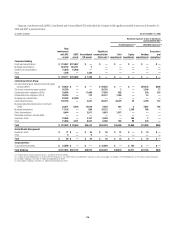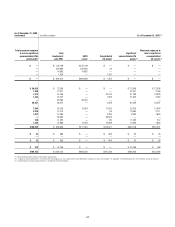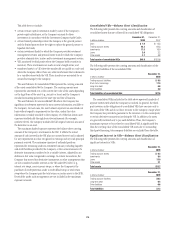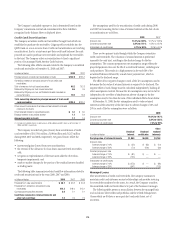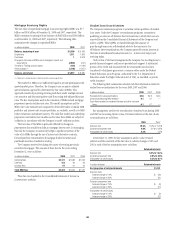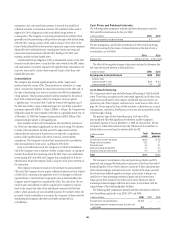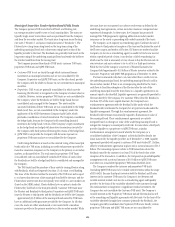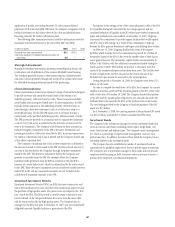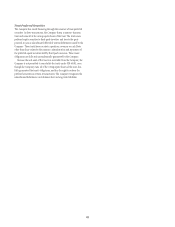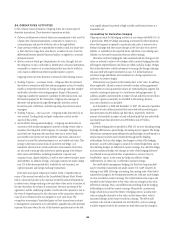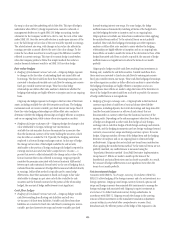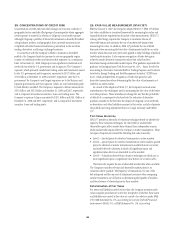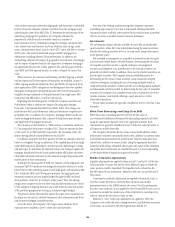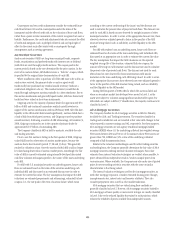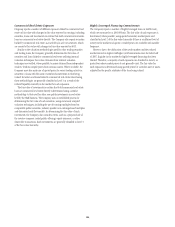Citibank 2008 Annual Report Download - page 192
Download and view the complete annual report
Please find page 192 of the 2008 Citibank annual report below. You can navigate through the pages in the report by either clicking on the pages listed below, or by using the keyword search tool below to find specific information within the annual report.Municipal Securities Tender Option Bond (TOB) Trusts
The Company sponsors TOB trusts that hold fixed- and floating-rate,
tax-exempt securities issued by state or local municipalities. The trusts are
typically single-issuer trusts whose assets are purchased from the Company
and from the secondary market. The trusts issue long-term senior floating
rate notes (“Floaters”) and junior residual securities (“Residuals”). The
Floaters have a long-term rating based on the long-term rating of the
underlying municipal bond and a short-term rating based on that of the
liquidity provider to the trust. The Residuals are generally rated based on the
long-term rating of the underlying municipal bond and entitle the holder to
the residual cash flows from the issuing trust.
The Company sponsors three kinds of TOB trusts: customer TOB trusts,
proprietary TOB trusts and QSPE TOB trusts.
•Customer TOB trusts are trusts through which customers finance
investments in municipal securities and are not consolidated by the
Company. Proprietary and QSPE TOB trusts, on the other hand, provide
the Company with the ability to finance its own investments in municipal
securities.
•Proprietary TOB trusts are generally consolidated, in which case the
financing (the Floaters) is recognized on the Company’s balance sheet as
a liability. However, certain proprietary TOB trusts are not consolidated by
the Company, where the Residuals are held by hedge funds that are
consolidated and managed by the Company. The assets and the
associated liabilities of these TOB trusts are not consolidated by the hedge
funds (and, thus, are not consolidated by the Company) under the
application of the AICPA Investment Company Audit Guide, which
precludes consolidation of owned investments. The Company consolidates
the hedge funds, because the Company holds controlling financial
interests in the hedge funds. Certain of the Company’s equity investments
in the hedge funds are hedged with derivatives transactions executed by
the Company with third parties referencing the returns of the hedge fund.
•QSPE TOB trusts provide the Company with the same exposure as
proprietary TOB trusts and are not consolidated by the Company.
Credit rating distribution is based on the external rating of the municipal
bonds within the TOB trusts, including any credit enhancement provided by
monoline insurance companies or the Company in the primary or secondary
markets, as discussed below. The total assets for proprietary TOB Trusts
(consolidated and non-consolidated) includes $0.9 billion of assets where
the Residuals are held by a hedge fund that is consolidated and managed by
the Company.
The TOB trusts fund the purchase of their assets by issuing Floaters along
with Residuals, which are frequently less than 1% of a trust’s total funding.
The tenor of the Floaters matches the maturity of the TOB trust and is equal
to or shorter than the tenor of the municipal bond held by the trust, and the
Floaters bear interest rates that are typically reset weekly to a new market rate
(based on the SIFMA index). Floater holders have an option to tender the
Floaters they hold back to the trust periodically. Customer TOB trusts issue
the Floaters and Residuals to third parties. Proprietary and QSPE TOB trusts
issue the Floaters to third parties and the Residuals are held by the Company.
Approximately $3.9 billion of the municipal bonds owned by TOB trusts
have an additional credit guarantee provided by the Company. In all other
cases, the assets are either unenhanced or are insured with a monoline
insurance provider in the primary market or in the secondary market. While
the trusts have not encountered any adverse credit events as defined in the
underlying trust agreements, certain monoline insurance companies have
experienced downgrades. In these cases, the Company has proactively
managed the TOB programs by applying additional secondary market
insurance on the assets or proceeding with orderly unwinds of the trusts.
The Company, in its capacity as remarketing agent, facilitates the sale of
the Floaters to third parties at inception of the trust and facilitates the reset of
the Floater coupon and tenders of Floaters. If Floaters are tendered and the
Company (in its role as remarketing agent) is unable to find a new investor
within a specified period of time, it can declare a failed remarketing (in
which case the trust is unwound) or may choose to buy the Floaters into its
own inventory and may continue to try to sell it to a third-party investor.
While the level of the Company’s inventory of Floaters fluctuates, the
Company held approximately $1.9 billion of Floater inventory related to the
Customer, Proprietary and QSPE TOB programs as of December 31, 2008.
If a trust is unwound early due to an event other than a credit event on
the underlying municipal bond, the underlying municipal bond is sold in
the secondary market. If there is an accompanying shortfall in the trust’s
cash flows to fund the redemption of the Floaters after the sale of the
underlying municipal bond, the trust draws on a liquidity agreement in an
amount equal to the shortfall. Liquidity agreements are generally provided to
the trust directly by the Company. For customer TOBs where the Residual is
less than 25% of the trust’s capital structure, the Company has a
reimbursement agreement with the Residual holder under which the
Residual holder reimburses the Company for any payment made under the
liquidity arrangement. Through this reimbursement agreement, the
Residual holder remains economically exposed to fluctuations in value of
the municipal bond. These reimbursement agreements are actively
margined based on changes in value of the underlying municipal bond to
mitigate the Company’s counterparty credit risk. In cases where a third party
provides liquidity to a proprietary or QSPE TOB trust, a similar
reimbursement arrangement is made whereby the Company (or a
consolidated subsidiary of the Company) as Residual holder absorbs any
losses incurred by the liquidity provider. As of December 31, 2008, liquidity
agreements provided with respect to customer TOB trusts totaled $7.1 billion,
offset by reimbursement agreements in place with a notional amount of $5.5
billion. The remaining exposure relates to TOB transactions where the
Residual owned by the customer is at least 25% of the bond value at the
inception of the transaction. In addition, the Company has provided liquidity
arrangements with a notional amount of $6.5 billion to QSPE TOB trusts
and other non-consolidated proprietary TOB trusts described above.
The Company considers the customer and proprietary TOB trusts
(excluding QSPE TOB trusts) to be variable interest entities within the scope
of FIN 46(R). Because third-party investors hold the Residual and Floater
interests in the customer TOB trusts, the Company’s involvement and
variable interests include only its role as remarketing agent and liquidity
provider. On the basis of the variability absorbed by the customer through
the reimbursement arrangement or significant residual investment, the
Company does not consolidate the Customer TOB trusts. The Company’s
variable interests in the Proprietary TOB trusts include the Residual as well
as the remarking and liquidity agreements with the trusts. On the basis of the
variability absorbed through these contracts (primarily the Residual), the
Company generally consolidates the Proprietary TOB trusts. Finally, certain
proprietary TOB trusts and QSPE TOB trusts are not consolidated by
186


